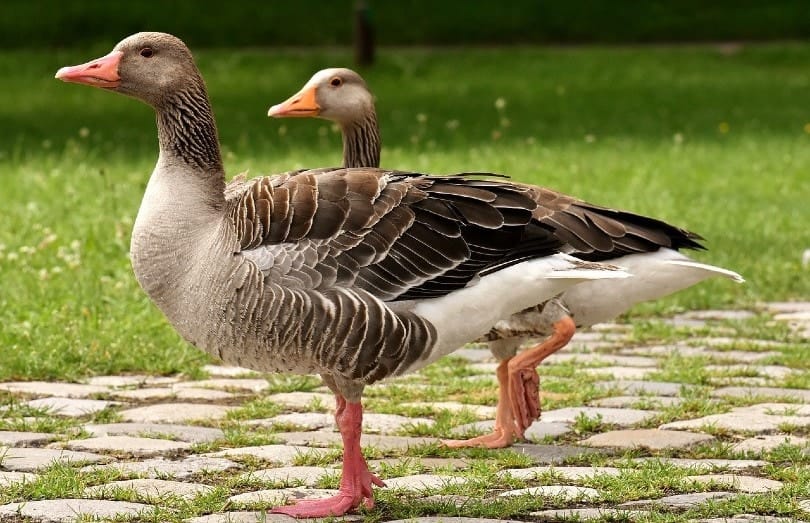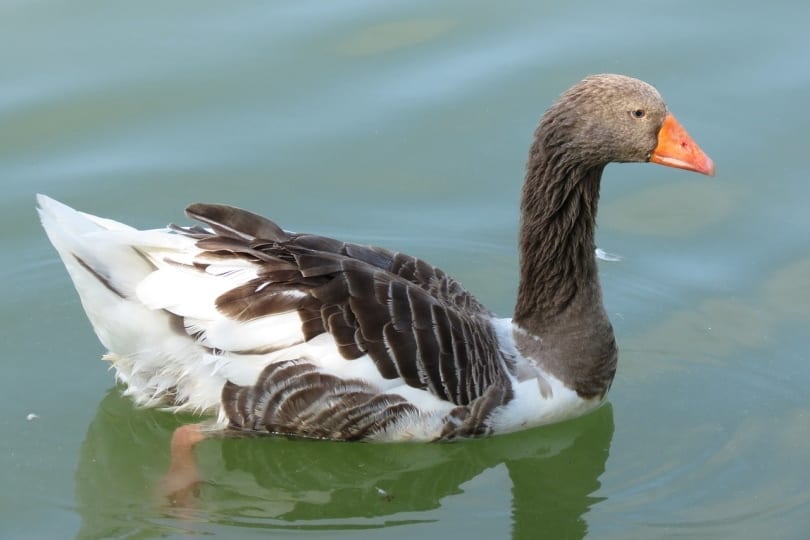The Toulouse goose is pretty recognizable and popular amongst poultry keepers for various reasons. These barnyard cuties are easy to keep, and they get along with just about any critter around. Plus, they’re a terrific multi-purpose bird.
These French geese have a lot to offer, and they are perfect for novice and experienced owners alike. Let’s get down to brass tacks so you can see if the Toulouse goose would make a charming addition to your farm.
Click to Skip Ahead:

Quick Facts About Toulouse Geese
| Breed Name: | Toulouse Goose |
| Place of Origin: | Anser Anser |
| Uses: | Meat, eggs |
| Male Size: | 19 – 20 pounds |
| Female Size: | 15 – 17 pounds |
| Color: | Gray to cream |
| Lifespan: | 10 – 20 years |
| Climate Tolerance: | Cold hardy |
| Care Level: | Beginner |
| Egg Production: | Moderate to high |

Toulouse Goose Origins
This little French goose—the Toulouse—was named after the city of Toulouse in France. Countryside at heart, these geese have made charming additions to farms all over the globe since their modest beginning.
Quickly after gaining some popularity in Europe, these birds started becoming a staple in the poultry industry. However, they are more often used today for egg production on small farms.

Toulouse Goose Characteristics
The Toulouse goose is a very relaxed, slow-paced goose that enjoys a lazy day every day. Not much can excite these geese—and they don’t really appreciate when something does. These geese mind their own business and get along well with others.
Because of their gentle nature, they’re very popular as 4H projects or barnyard pets. They will be mild toward children, and they don’t show as many territorial tendencies as some.

Uses
The Toulouse goose is a very useful farm fowl. Since these geese are heavy-bodied, they make amazingly delicious table birds. The liver of a Toulouse is oversized, making them a source of foie gras.
They make decent layers as well. Annually, a Toulouse goose produces between 25 and 35 large eggs.
It is also common for Toulouse to be a source of down feathers in products. They have just the right density and texture.
Appearance & Varieties
At first glance, these geese are recognizable because of their bulky, rectangular body shape and white and neutral-toned plumage. These heavy geese are large and slow with a wide waddle.
- Oie de Toulouse a bavette — heavy-bodied, industrial type with dewlaps. The Toulouse geese with dewlaps are suitable for both eggs and meat.
- Oie de Toulouse sans bavette — light agricultural type without dewlaps. This type of goose is considered the industrial type, not having much use for anything other than meat.
Originally, the Toulouse goose was gray, but white was accepted in 1982 and buff in 1997.

Population, Distribution & Habitat
Originally, the Toulouse goose was only found in one place—Toulouse, France. However, you can find Toulouse breeders near you in just about any place these days.
Toulouse geese tend to be generally inexpensive, with females costing slightly more than males—permitting they are sexed.
These geese are popular options because of their usefulness, gentle temperament, and overall hardiness.

Are Toulouse Geese Good for Small-Scale Farming?
The Toulouse goose is a good candidate for farm living in the right circumstances. Since they are docile and non-aggressive, they might have issues standing ground against more territorial geese.
They are moderate layers, producing up to 35 large eggs per year. Their feathers can be profitable, too. If a Toulouse goose sounds like the right breed for you, look locally for options.
Featured Image Credit: OrnaW, Pixabay
